
Koror is the state comprising the main commercial centre of the Republic of Palau. It consists of several islands, the most prominent being Koror Island.

Pomacentridae is a family of ray-finned fish, comprising the damselfishes and clownfishes. This family were formerly placed in the order Perciformes but are now regarded as being incertae sedis in the subseries Ovalentaria in the clade Percomorpha. They are primarily marine, while a few species inhabit freshwater and brackish environments. They are noted for their hardy constitutions and territoriality. Many are brightly colored, so they are popular in aquaria.
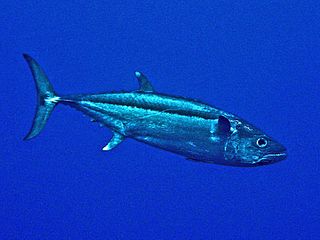
The dogtooth tunaGymnosarda unicolor, also known as white tuna, is a species of pelagic marine fish which belongs to the family Scombridae.
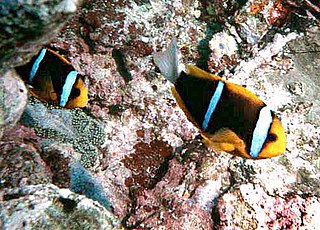
The orange-fin anemonefish is a marine fish belonging to the family Pomacentridae, the clownfishes and damselfishes, found in the Western Pacific north of the Great Barrier Reef from the surface to 20 m, to include the Pacific Ocean between Queensland, Australia, and New Guinea to the Marshall and Tuamotus Islands. It can grow to 17 cm in length.
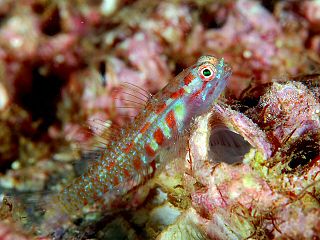
Eviota is a genus of fish in the family Gobiidae, commonly as dwarfgobies found in the Indo-Pacific region, where it is distributed from Japan to Australia and from Africa to Pitcairn Island. Species are mainly associated with coral reefs. Many of these fish are short-lived, with life cycles as brief as 3.5 weeks in the tropics. Some species are hermaphrodites and some representatives live symbiotically among the tentacles of the mushroom coral.
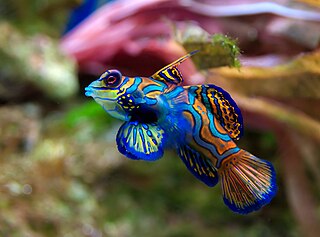
Pacific Abyss is a three-part series on British television's (BBC1), which first aired in Sunday 17 August 2008. It is hosted by Kate Humble, Mike Smart and Mike deGruy with filming beginning in April/May 2007.
Chromis abyssus is a species of damselfish first discovered in 1997 and described in 2008. The 8 centimetres (3.1 in) long fish only lives more than 110 m (361 ft) below the surface of the Pacific Ocean around the coast of the Ngemelis Islands, Palau. Adults have been observed living singly or in pairs, whereas juveniles tend to live in groups.

Trimma cana, the Candy cane pygmy-goby, is a species of goby native to the western Pacific Ocean where it can be found from the Philippines to Palau. It inhabits steep slopes on the outer side of reefs, preferring a hard coral substrate, at depths of from 12 to 35 metres. This species can reach a length of 2.5 centimetres (0.98 in) SL.

The sailfin snapper, blue-lined sea bream or blue-lined sea perch is a species of marine ray-finned fish, a snapper belonging to the family Lutjanidae. It is native to the Indo-Pacific region. It is of minor importance to local commercial fisheries and can be found in the aquarium trade. It is currently the only known member of its genus.
Chromis brevirostris, or colloquially known as the shortsnout chromis, is a type of damselfish that was described in 2008 by R. Pyle, J. Earle, and B. Greene in the western Pacific Ocean. This species comes from the genus Chromis which contains eighty species and counting, including C. abyssus, C. circumaurea, C. degruyi, and C. earina. Chromis brevirostris can be found in the Pacific Ocean, located as far north as the Marshall Islands to as far south as Fiji and Vanuatu, and spanning from Palau to Paluwat of the Caroline Islands. The species’ name, Chromis brevirostris, derives from Latin origin; brevis and rostrum mean “short” and “snout” respectively. It is generally abundant in its environment, living at depths of 90–120 metres (300–390 ft), tending to live in groups ranging in size from six to several dozen.

Munidopsis serricornis is a species of squat lobster. It is widely distributed in the world's oceans, being found in the eastern Atlantic Ocean, the western Atlantic Ocean, and the Indo-Pacific. It grows up to a carapace length of 20 millimetres (0.8 in).
The tentacled dragonet is a species of dragonet native to tropical reefs in the western Pacific Ocean.

Trimma is a genus of fish in the family Gobiidae native to the Indian and Pacific Ocean. Together with members of the genus Eviota, they are known commonly as pygmygobies or dwarfgobies.

Kyphosus ocyurus, the blue-striped chub or rainbow chub, is a species of marine ray-finned fish, a sea chub from the family Kyphosidae. The species is found in the Pacific Ocean where it prefers rocky substrates.

Acropora lutkeni is a species of acroporid coral found in the central Indo-Pacific, Japan, Australia, the northern Indian Ocean, the East China Sea, southeast Asia, and the central and western Pacific Ocean. The species also occurs in the south Mariana Islands, American Samoa, Palau, the Andaman Islands, Fiji, the Philippines, the Banggai Islands, Samoa, the Raja Ampat Islands, the Line Islands, Papua New Guinea, and the Chagos Archipelago. It exists in tropical shallow reefs on upper slopes that are exposed to the action of strong waves or currents, and subtidally on edges of reefs and in submerged reefs. It exists at depths of between 3 and 12 metres and probably spawns in October.

Acropora humilis, also known as finger coral, is a species of acroporid coral found in the Gulf of Aden, the Red Sea, the northern and southwestern Indian Ocean, Australia, the central Indo-Pacific, Japan, southeast Asia, the East China Sea, the central and western Pacific Ocean, the Johnston Atoll and the northwestern Hawaiian Islands. It also occurs in the Raja Ampat Islands, Mariana Islands, Palau, and the Pitcairn Islands. Occurring in tropical shallow reefs on upper reef flats and slopes at depths of up to 12 metres (39 ft), it was described by Dana in 1846.

Trimma nasa, commonly called the nasal dwarfgoby or nasal pygmy goby, is a species of goby from the Western Pacific. They are small fish, averaging at around 2 cm (0.79 in) in length. They are bright orange and transparent yellow in life, with a white stripe running down from between the eyes to the upper lip and a dark brown spot at the base of the tail fin. They are usually found in large schools in the sloping or vertical drop-offs at coral reef edges.
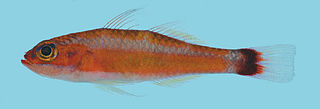
Trimma caudomaculatum, the blotch-tailed pygmygoby , is a species of goby from the Western Pacific. Like other members of the genus, they are usually found in large schools in the sloping or vertical drop-offs at coral reef edges. Similar to other species of Trimma this species consists of multiple cases of bidirectional sex change, meaning that if a group is lacking in a specific sex a partial amount of the group can change their undeveloped gonad structure of the opposite sex in order to accommodate. This sex change is made possible due to the females having a developed set of ovaries with female hormones that are developed, and a set of testis and male hormones that are underdeveloped; The males follow a similar set up in vice versa, so their testis and male hormones are developed, while the ovaries and female hormones are underdeveloped.
Chromis degruyi is a species of fish in the family Pomacentridae. It was first found at depths greater than 60 metres (200 ft) in a coral reef habitat in the western Pacific, specifically the Caroline Islands. It differs from its cogenerates on a colour and morphological basis.
Anacropora forbesi is a species of briar coral that can be found in the tropical western and central Indo-Pacific region. It is the type species of the genus Anacropora.














